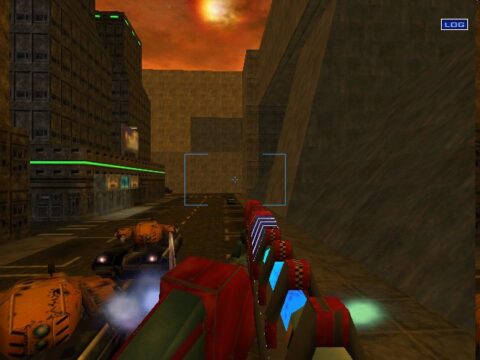
Shogo: Mobile Armor Division
Written by: Rik
Date posted: March 6, 2005
- Genre: Action
- Developed by: Monolith
- Published by: Microids
- Year released: 1998
- Our score: 7
Big robots stomping around city centres, anime presentation and a ludicrous storyline: these are the core ingredients of Monolith’s Shogo: Mobile Armor Division. From a personal point of view, it doesn’t sound too promising – for a start, big walking robots are a daft concept, and to have them walking around in populated areas firing rockets is just plain dangerous. It’s a good job most of the buildings are made out of indestructible material; otherwise each mission would incur a civilian bloodbath.
Released in 1998 to moderate acclaim, Shogo is one of a host of Half-Life challengers which failed to match up. See, despite the big-robot action, Shogo is essentially a FPS, and people who run screaming from the likes of Mechwarrior have nothing to fear here. You won’t be messing around with weapon collaborations, setting the throttle or moving to waypoints – it’s essentially blasting all the way. You control your mech (mecha, or MCA in Shogo-speak) with the standard FPS controls, making movement a cinch, and weapons are selected with the number keys, a la virtually every FPS in living memory. In addition, a good amount of time is spent out of your mecha: there are a number of missions which take place on foot, and as the game progresses you’ll find that your MCA is increasingly used to take you from one indoor scenario to another.
Context is provided by an ever-unfolding plotline. The people of the planet Chronos are at war with each other. The Cronian Mining Confederation (CMC), having wrested control from the United Corporate Authority (UCA), are now under threat from a terrorist organisation known as The Fallen. The two sides agree to stop fighting each other temporarily in order to bring down The Fallen, although it’s not exactly a case of working together: for the UCA, eliminating the Fallen brings the opportunity to re-take control of Chronos.
You play Sanjuro, a UCA commander and a bit of a cocky upstart too if we’re honest. It’s an approach which has obviously worked for you in the past though, as you’ve managed to score with a couple of women, both daughters of your commanding officer to boot. Actually, you’re only going out with your current beau, Kathryn, because her sister went missing on an undercover mission a while back. Without giving too much away, this all adds up to a bit of a love-triangle scenario later on, with the added ‘spice’ of your boss’s disapproving comments throughout.
Not exactly original stuff – indeed, it’s been done before and better. Conversations are usually extremely brief, and take place almost exclusively over radio. The script consists of throwaway witticisms and mission-related detail, with little attention given to character development. Consequently, the story is unlikely to keep you on the edge of your seat, with major plot developments barely registering as you plough through the levels. In fact, it’s perfectly possible to play through the entire game without the detail of the whole UCA/CMC situation ever sinking in. Still, Shogo‘s story is hardly a hateful pile of shit – it’s entertaining enough in a cartoony kind of way, and certainly nowhere near as dreadful as something like SiN – it’s just nothing particularly special.
The game itself is an entertaining, old-school FPS romp, however, and after a few minutes’ play you’ll soon have adopted the traditional hunch over your PC, lights down, eyes wide and quicksaving at will. The MCA sections don’t lose too much authenticity because of the FPS controls, although it has to be said they’re all pretty sprightly fellas, scampering around the cities like big, metal people with none of the oft-quoted disadvantages of huge walking robots ever becoming apparent. Despite the fact that you tower above buildings and cities, and that the telltale sound of steel on tarmac accompanies your every step, you occasionally need reminding that you’re supposed to be controlling a huge hunk of metal.
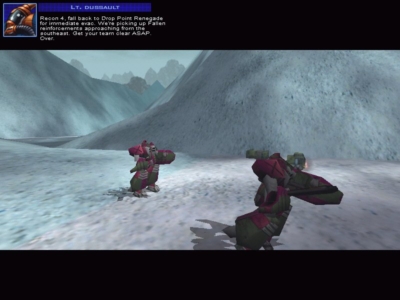
The MCAs never really move like they’re towering hunks of steel, especially when the game moves to an external view (in this case for a cut-scene).
Still, there’s never any danger of Shogolacking a proper sense of scale in these sections. You’ll soon learn to watch your step once you’ve trodden on a few stationary cars and caused substantial damage to yourself, while some of the firefights you become embroiled in occasionally border on the spectacular. Rockets spew smoke on the way to their targets, debris flies in all directions (although none of the scenery ever suffers any damage), and the impact of every shot, hit or miss, can always be felt. The levels are all a little on the small side, but it does mean that you spend very little time getting lost and more time unleashing your arsenal. The on-foot sections are also fun, if hampered a little by terrible enemy AI. Opponents are somewhat short-sighted, meaning you can sneak around them and pick them off before their attention is ‘triggered’. Once this happens though, they can dispatch you in alarmingly quick time, and you certainly can’t take too much in the way of damage without death swiftly following. Apart from the combat, the puzzles are generally of a ‘find the key’ nature, although there is a bizarre dog-rescuing scenario which involves a squeaky toy being added to your armoury.
Presentation-wise, it still looks pretty good. The graphics are solid and neat, even if they are showing their age a little. In particular, the out-of-MCA sections feature some crude character graphics, especially the faces, which appear to have been ironed on. The sound is also reasonable, with meaty explosion effects, some half-decent voice acting, and, best of all, some cheese-laden synth-rock during the introduction. The whole effect is that of a Japanese cartoon, and it seems likely that you’ll look on Shogo more favourably if you’re into anime. If you’re not, then preparing yourself for something that wouldn’t be out of place on Saturday morning television might help you get into it. You might also be more forgiving about the story and script: I played Shogo with a memory of some glowing praise for this aspect of the game (characters you really care about’, that kind of thing) and came away disappointed as a result.
The only other black mark against Shogo‘s name is the amount of time it takes to finish. Lord knows how long it would take a skilled FPS player, but it took me, a man who would be laughed off any Quake server, two days on ‘normal’ difficulty, and that’s including proper meal and sleep breaks. Frankly, it’s a little on the short side. There are elements of a branching storyline and mission structure, but unless you really engage with the plot it’s unlikely you’ll go back and replay it just to see what happens. Leaving all this aside, however, Shogo is an extremely enjoyable game while it lasts, and those FPS fans who were too busy playing Half-Life back in 1998 to notice anything else would do well to seek it out.

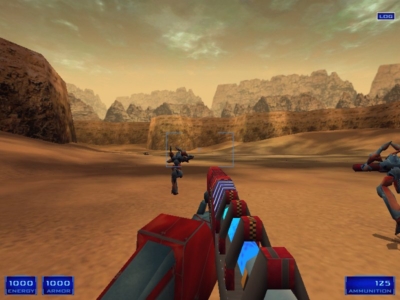
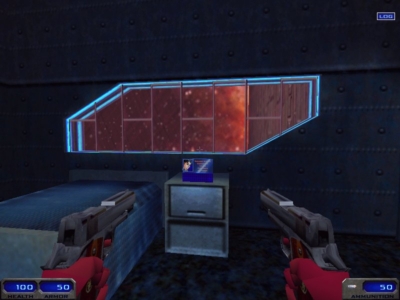
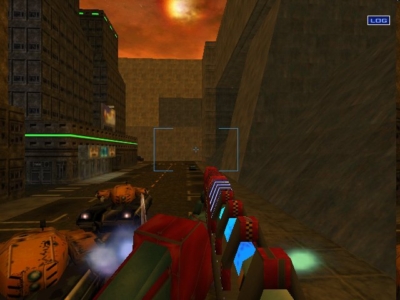

 Posts
Posts